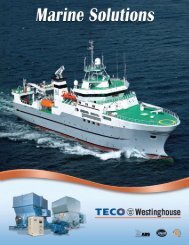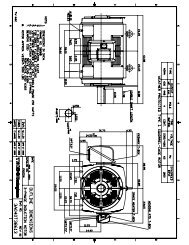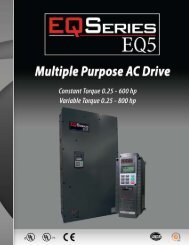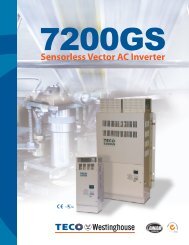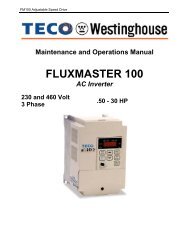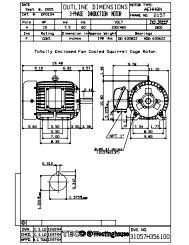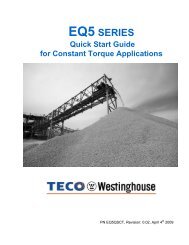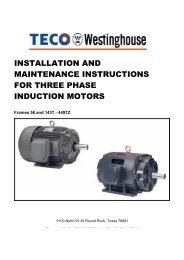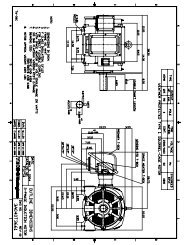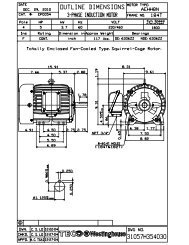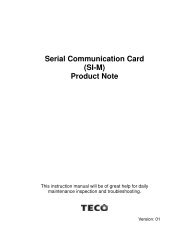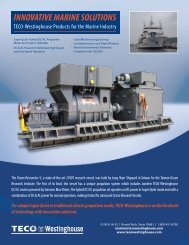EQ7 Series Instruction Manual - TECO-Westinghouse Motor Company
EQ7 Series Instruction Manual - TECO-Westinghouse Motor Company
EQ7 Series Instruction Manual - TECO-Westinghouse Motor Company
Create successful ePaper yourself
Turn your PDF publications into a flip-book with our unique Google optimized e-Paper software.
DC link bus terminals P(+) and N(-)<br />
Capacity<br />
(HP)<br />
Braking<br />
transistor<br />
Built-in DC braking<br />
resistor (DBR)<br />
50 to 1000 None None<br />
Optional devices<br />
Braking unit<br />
DC braking resistor<br />
(DBR)<br />
Devices and terminals<br />
Inverter - Braking unit:<br />
P(+) and N(-)<br />
Braking unit -DBR:<br />
P(+) and DB<br />
1) Connecting an optional braking unit or DC braking resistor (DBR)<br />
Inverters of 50 HP or above require both a braking unit and DBR.<br />
Connect the terminals P(+) and N(-) of a braking unit to those on the inverter. Arrange the inverter and the braking<br />
unit so that the wiring length comes to 16 ft (5 m) or less and twist the two wires or route them together in parallel.<br />
Next, connect the terminals P(+) and DB of a DBR to those on the braking unit. Arrange the braking unit and DBR<br />
so that the wiring length comes to 33 ft (10 m) or less and twist the two wires or route them together in parallel.<br />
For details about the wiring, refer to the Braking Unit <strong>Instruction</strong> <strong>Manual</strong>.<br />
2) Connecting other external devices<br />
A DC link bus of other inverter(s) or a PWM converter is connectable to these terminals.<br />
When you need to use the DC link bus terminals P(+) and N(-), consult your <strong>TECO</strong>-<strong>Westinghouse</strong> <strong>Motor</strong><br />
<strong>Company</strong> representative.<br />
Switching connectors<br />
• Power switching connectors (CN UX) (on inverters of 125 HP or above for 460 V)<br />
Inverters of 125 HP or above for 460 V are equipped with a set of switching connectors (male) which should be<br />
configured according to the power source voltage and frequency. By factory default, a jumper (female connector) is set<br />
to U1. If the power supply to the main power inputs (L1/R, L2/S, L3/T) or the auxiliary fan power input terminals (R1,<br />
T1) matches the conditions listed below, change the jumper to U2.<br />
For the switching instructions, see Figures 2.6 and 2.7.<br />
(a) <strong>EQ7</strong>-4125-C to <strong>EQ7</strong>-4200-C<br />
Connector<br />
configuration<br />
CN UX (red)<br />
CN UX (red)<br />
Power source voltage<br />
398 to 440 V/50 Hz, 430 to 480 V/60 Hz<br />
(Factory default)<br />
380 to 398 V/50 Hz<br />
380 to 430 V/60 Hz<br />
(b) <strong>EQ7</strong>-4250-C to <strong>EQ7</strong>-41000-C<br />
Connector configuration<br />
CN UX (red)<br />
CN UX (red)<br />
Power source voltage<br />
398 to 440 V/50 Hz, 430 to 480 V/60 Hz<br />
(Factory default)<br />
380 to 398 V/50 Hz,<br />
380 to 430 V/60 Hz<br />
The allowable power input voltage fluctuation is within -15% to +10% of the power source voltage.<br />
2-14



